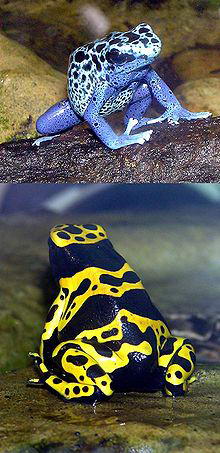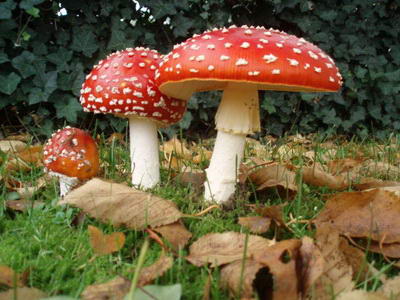1. Scorpion
Scorpion is a group of segmented animals with eight legs (oktopoda) are included in the order Scorpiones in the class of arachnids. Scorpions are still allied with the scorpion, spiders, mites, and ticks. There are about 2000 kinds of scorpions. Scorpion body is divided into two segments: the cephalothorax and abdomen. The abdomen consists of the mesosoma. All species of scorpion have a can. In general, scorpions can be included as a neurotoxin (nerve poison). An exception is Hemiscorpius lepturus which could have a cytotoxic (cell toxic). Neurotoxins consist of small proteins as well as sodium and potassium, which is useful to interfere with nerve transmission of the victim. Scorpion venom used to kill or paralyze their prey so easy to eat.
Centipede or Centipede (English: centipede) is an arthropod animals belonging to the class Chilopoda and Myriapoda upafilum. Centipede is metameric animal that has a pair of legs on each body segment. These animals including venomous animals, and includes a nocturnal animal.
Caterpillars are the larval stage of species within the order Lepidoptera, which includes butterflies and moths. Most are plant-eaters, although some species are insect eaters. Most caterpillars are considered as pests in agriculture. Many species of moths known for his stage caterpillars cause damage to fruit and other agricultural products.
1. Head
2. Chest
3. Stomach
4. Spirakulum
5. Anal hooks
6. Limbs stomach (abdominal)
7. Segment
8. Limbs Chest (thoracis)
9. Antenna
Most caterpillars have long bodies and gilig shaped (cylindrical). Caterpillars have three pairs of true legs on the three segments of the chest, coupled with four pairs of false legs, called limb segments of the abdomen in the middle of the abdomen and often a pair of abdominal legs on the last abdominal segment. Caterpillars have ten abdominal segments
Images of thread-waisted wasp Ammophila Ammophila waspThe thread-waisted wasps are long, black and red-orange with a thin waist, or pedisel, connecting the stomach and chest, and long hind legs. Body design resembles a helicopter Sikorsky Skycrane, an adaptation has a practical purpose - this is a solitary wasp hunting caterpillars, designed to bring a lot of caterpillars to feed their offspring. It looks similar to a wasp cutworm Podalonia men.
This species is a solitary wasp hairy caterpillars prefer to feed the larvae. This sting prey to paralyze it, so the food stays fresh but did not crawl away. Wasps will fly immobilized prey to shallow ground nests, lay eggs on it and close the hole. Hornet nests may have some holes, and remember their location, can re-open and re-provision them with more food. Its offspring hatch, consume the host for the week prior to devour and kill them, and pupates underground before emerging in the mid to late summer as a single adult.
Adult wasps feed on nectar of flowers. Hornet imagine about two inches long and is found feeding on flower nectar rabbitbrush. Starting all over the United States and southern Canada, prefer inhabit open areas.
Unlike most other frogs, a species which is active in the daytime, and often show bright-colored body. [2] Although all dendrobatids at least somewhat toxic in the wild, the level of toxicity varies from one species to the next, and from one population to another. Many species are critically endangered and extinct. [3] Amphibians are often called by the native indian dart frogs due to the use of their toxic secretions to poison the tip of his arrow.
Most of the frogs of this type has a body size of 1.2 cm for adult frogs, although there is a frog the size of up to 6 cm. The average size of their weight about 2 grams. These brightly colored frogs in addition to also showing a pattern aposematik to warn potential predators. their bright colors associated with them and toxicity levels of alkaloids. Frogs as Dendrobates species have high levels of alkaloids
Tarantula '(as the term used in North America) comprises a group of hairy and often very large arachnid family Theraphosidae, of which about 900 species that have been identified. Some members of the suborder same can also be called a "tarantula" in common language. This article will limit itself to members explaining the Theraphosidae. Brazilian tarantula in attacking positions
Several genera of tarantulas hunt prey primarily in trees; hunting other people at or near the ground. All tarantulas can produce silk, while arboreal species will typically be in a "tube tent" silk, terrestrial species will line their burrows with silk to stabilize the burrow wall and facilitate climbing up and down. Tarantulas generally eat insects and other arthropods, using ambush as their primary method of capturing prey. The biggest tarantulas can kill large animals such as lizards, mice, and birds. Tarantulas are found in tropical and desert regions around the world. Most tarantulas dangerous to humans, and some types are popular in the exotic pet trade. All tarantulas are venomous, but only few species have venom that, although not known to have produced human fatalities, can result in extreme discomfort for several days.
Box Jellyfish / Stinger / Sea Wasp / Fire Medusa / Indringa (box jellyfish) Species - Chironex fleckeri box jellyfish-shaped transparent blue, bell or cube with 4 sides. Its speed to 4 knots. The length of each side 20cm (1-3 feet), body diameter 20-40 cm (1-16 inches), but there are up to 2m (6.5 feet). With 15 tentacles on each corner, with a length up to 3m, up to 5000 nematocyst (stinger cells). Like other cnidarians, jellyfish stings have cells (cnidocyte) containing a nematocyst on the tentacle. A capsule (nematocyst) in the tool could (cnidoblast) consists of the trigger structure and stinging. When victims come into contact with the tentacle, hundreds to thousands of nematocyst issued. Pressure forcing nematocyst stings spread rapidly, paralyzing toxin. Can (Venomous) No chance of survivors of the sting can be quickly handled exception. Taste is very ill to anaphylactic shock and drown before reaching the beach although not all can work. People who are stung should be treated like a snake bite victim and immediately taken to hospital after first aid. Highly toxic shock which can cause death. Predators are very toxic. Known also as the sea wasp, jellyfish salad bowl this size can have 60 tentacles 15 feet long, and each can have tentacles sting 5000 cells in the epidermis, and has enough venom to kill 60 humans. So a total of 3600 people could die by a jellyfish. Toxins in the form of a lethal dose LD50 (Lethal Dose), the form can be 40 micrograms / kg. Even ordinary sting can cause death within a few minutes with a mortality rate of 20% occurred respiratory failure, neuromuscular paralysis, and cardiovascular failure. Symptoms are burning, redness, and swollen lymph glands. The reaction was difficult to breathe even heart failure.
Bombardier beetle is one of the popular insects for using chemical methods to protect themselves from enemies. In case of danger, this insect squirts hydrogen peroxide and hydroquinone stored in its body into the enemy to protect themselves. Before the fight, special arrangements are called lobe expenditures made both concentrated mixture of these chemicals. This mixture was kept in a separate room called the storage space. This space is connected with the second chamber called the blasting chamber. Both of these spaces kept separate from each other by the sphincter muscle. When the insect is sensing the danger, the muscles that surround the storage space contracts while the sphincter muscles relax, so that the chemical substances in the storage room flows into the blasting chamber. A large amount of heat released and there was evaporation. Vapor and oxygen gas exert pressure on this slide walls blasting chamber and sprayed chemical substances into the enemy through a duct that leads out of the beetle's body.
Some mushrooms safe to eat humans and even some medications are considered nutritious, such as mushroom (Volvariela volvacea), oyster mushrooms (Pleurotus), ear fungus (Auricularia polytricha), button mushrooms or champignon (Agaricus campestris), and shiitake mushrooms (Lentinus edulis). A poisonous mushroom Amanita muscaria example is, and fungi known as the "destroying angel".
The characteristics of Poisonous Mushrooms
(A) The type of poisonous mushrooms generally have striking colors: red-blood-jet black, blue-parents, or other colors. Although there is also a type of poisonous mushroom that has a bright color (yellow) or white, and edible mushrooms, dark, chocolate-old example.
(B) The type of toxic mold can result in nose piercing smell, like rotten egg smell or odor ammoniak.
(C) The types of poisonous mushrooms have a ring or cup. Although there is an opposite, like mushrooms, straw mushroom compost has a cup and have the ring, but not toxic.
(D) The types of poisonous mushrooms generally grow in a dirty place: landfills, sewage cage, and so on. Although for the establishment and maintenance of mushrooms instead used dirt compost barn / horse dung.
(E) If the type of poisonous mushroom cut off by a knife made of silver, or cut off by the usual knives and silver objects brought near to the crate before, then the object is formed black silver or blue, it indicates that the mushroom is poisonous.(F) The types of poisonous mushrooms change color rapidly, eg from white to dark colors, if cooked or heated.
(G) There is a hereditary habits among farmers in the village to determine if toxic mold or not, by mushroom wrap with white rice. If then color the rice turns into a dark color, indicating that the sort of poisonous mushrooms.(H) In many European countries and America, many "mushroom hunters" who accidentally bring a pig trained to distinguish the types of toxic and did not.
Anemone body shape like a flower, so it is also called a sea of roses. Creases round the mouth piece between the body and divides these animals into the capitulum at the top and bottom of the scapus. Among the arches like the neck (collar) and the base of the capitulum there is a "fossa". Shaped mouth pieces flat, circular, sometimes contract, and is equipped with tentacles except on the type Limnactinia, mouth pieces are not equipped with tentacles. Some sea anemones can move like a snail, move slowly by way of sticking. Most of the sea anemone have stinging cells that are useful to protect themselves from predators.




















